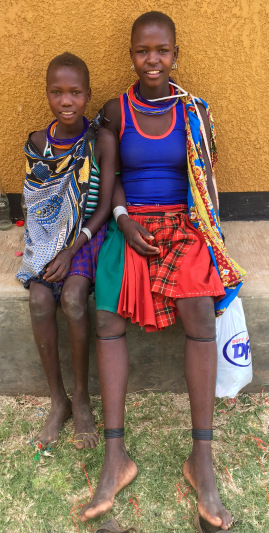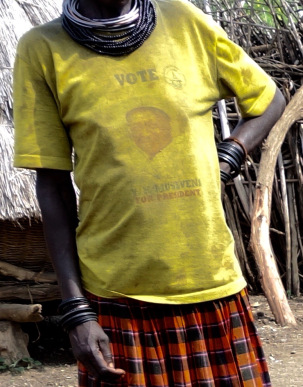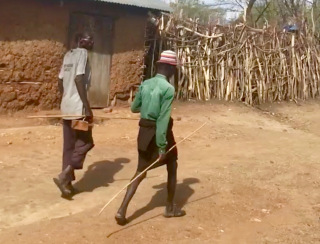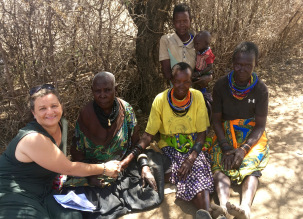Being an ethnographer: Are we becoming friends or is this just research?

I’m writing in the arid, breezy shade outside my £10-per-night hotel in northeastern Uganda. This weekend, I’m taking a break from PhD life. Not really. I’m actually here to interview alumnae from the secondary school where my research is based.
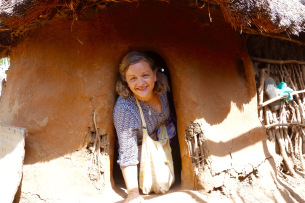
Jacqueline Gallo in Uganda
Being an ethnographer, every day and every moment can be a research moment. There is taking a break, but not turning off. My master’s supervisor, Dr. David Mills, with Morton, describes on the first page of their book that ethnography is ‘being, seeing, writing. Simple participles that belie the complexity of their meanings’ (Mills & Morton, 2013). They write about education in the broadest sense of the word, including formal and informal education settings.
My research brought me to northeastern Uganda for the year, studying how secondary school girls are preparing to exit school and embark on a life beyond their all-girls, Catholic-founded boarding school. I am writing this post for students considering, preparing for, or interested in ethnography in education.
So, why I am staying in a hygienically challenged hotel only thirty minutes from my home site? I’m here because life is blurred. I am not from this land, and although adopted by members of the local Karamojong people, I am not one of them. If ethnography requires seeing, being, and writing, then I am embracing it entirely.
This year, I am working at the oldest school for girls in this region as a teacher while also researching there. This school is in the heart of a historically war-torn region that today is ‘peaceful,’ so long as ‘peaceful’ only means that tribal cattle-raiding with AK-47s and roadside ambushes are a thing of the past. Today, severe food insecurity, chronic poverty, forced marriage, and the highest gender-based violence statistics in the nation plague the region still (Irish Aid, 2010). Only 2% of the girls here have completed lower secondary school and a mere 1% have completed upper secondary school (UNESCO, 2011).
Two illiterate sisters, part of the 99% of girls who do not step into a secondary school, rest after they’ve completed a sowing job.
If I am to study how prepared these girls will be for life after secondary school, then I must know more than just who they are and how they feel now. Ethnography demands context and genuine immersion into others’ lives. I need to move beyond just their school environment. Immersion is mandatory into the whole of their situation. This means meeting school alumnae, parents, learning their language, and getting to know the women who came before, and those among them who lead challenging lives without having had formal education.
During preparation for this and my previous ethnographic study, well-intentioned people inquired about my ability to cope with the basics of moving abroad. But this isn’t just moving abroad, this is research. And this isn’t a personally removed form of research. This is immersive; full-on ethnography which is full of vulnerability, risk, and complication, drowned in enduring questions: Is this moment ‘research’ or just my life right now? Does this new knowledge belong in a travel journal or my research journal? Perhaps the most difficult… are we becoming friends or am I still researching?
There are no easy answers because your ontological and epistemological underpinnings and the context of everything, matters. The best answer I can give is to advise budding ethnographers that the research ‘hat’ is always on. I like this metaphor, albeit clichéd because Ugandan President Museveni loves wearing big cowboy hats with a string around his neck – this signature style is plastered on worn, bright campaign shirts throughout the region. It is the same for the ethnographer; the hat is always on. You might complement the hat with a decorative feather like Karamojong men or take it off your head to have small moments to yourself, but the hat is at least around your neck if not fully on your head.
A worn out but still worn campaign shirt of President Museveni in his signature cowboy hat
I imagine this is easier for me as I am researching in a country where I do not have previous work experience, nor did I grow up here. I offer this metaphor because keeping the hat on, I imagine, would be especially challenging if performing research in an environment that was previously known to you. Caution is advised!
Today, I was invited to the mud home of a promising alumna whom I interviewed a few weeks ago. I was challenged, asking myself if the hat was still on or were we becoming friends? This kind, talented woman is helping me connect with other school alumnae and will serve as my interpreter for interviewing parents. Hat on – snowball selection. But how firmly placed and solitary is this hat?
I choose to think of this budding relationship as professional, and perhaps, the start of genuine friendship. When she and her mother invited me to visit her sick brother in the local missionary hospital, I believe I was invited as a friend. But just as President Museveni wouldn’t take off his hat in the blistering sun, I did not take mine off either because the hospital visit is an opportunity to learn about life’s challenges here. I think of this visit as wearing my hat but putting a decorative friendship feather on the side.
Typical man of the region with his knitted hat and signature stick of the pastoralists. Men sow their own hats here and decorate them with ostrich feathers.
I encourage others to consider this hat metaphor because you may think you already know how to handle this immersive and holistic methodology, just as I thought I knew when I arrived in Kenya for the first time. However, looking back at field notes from my Master’s study, I am still shocked at how isolated I felt during the deep immersion. My isolation and despair is exemplified from this troubling field note:
I am never alone. I…take walks into the valley and hide under bushes or trees to have a moment of silence. This doesn’t work. Before long…a Maasai herder will spot me across the valley and come to show me his cattle – after a short session in pantomime, we sit in silence but together. I must accept I will have no time to myself and make the most of my time outside the home, albeit never alone, at the Maasai church on Sundays or with market women who teach me beading. I am a spectacle anywhere I go, with curious and sometimes suspicious stares my way, being shouted at by passers-by, or politely exchanging pleasantries with curious, friendly Kenyans, when all I want to be is invisible.
When all I want to be is invisible – I can see now that I did not yet know how to wear the ethnographer’s hat. It was new, awkward, and not fitted to my head. Now, I am learning how to decorate my hat whilst keeping it on. In the rare instances where my internet is strong enough, I will watch a little American TV to relax. I don’t take my hat off entirely but keep the string around my neck because even these moments of relaxation, moments of home, help me learn about myself as a researcher and what I need so that I may never desire to be invisible again.
I often visit these women in the village. We take a photo each time to see how we change. They know I’m a researcher and encourage photos to share their lives with the world “ulayá ” or abroad.
How will you wear your hat? Take the hat cliché to heart, my dear ethnographers; it will save you from isolation, loneliness, and becoming too comfortable.
The last thing to mention here is that whilst writing this post from the shade behind my palace of a hotel, a goat jumped out from behind the building, less than a meter away, with a big BAAAAH! I jumped in surprise, almost throwing my computer into the dirt, beyond my blanket. I saved the computer and remind you to be ready for the unexpected and keep your hat on a string!
References:
- Irish Aid. (2010). Country Strategy Paper 2010 – 2014 Summary Uganda.
- Mills, D., & Morton, M. (2013). Ethnography in education. London: Sage.
- UNESCO. (2011). Global Education Monitoring Report. Retrieved from http://www.education-inequalities.org/
At the time of the original publication, Jacqueline Gallo (@Jgallovanting) was a second year PhD student in the Faculty of Education, University of Cambridge. This story was first published on March 29, 2017, on the FERSA Blog run by graduate students at the Faculty of Education in Cambridge (available here) and has been republished here with permission.
